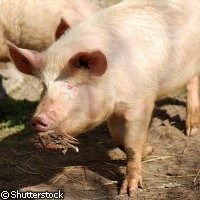A/H1N1 virus rears its ugly head in... pigs
Researchers in Germany have added a twist to the pandemic currently affecting humans: the influenza virus A/H1N1 has been shown to be infectious in pigs and to spread quickly in a trial pig population. Published in The Journal of General Virology, the results of the study are part of the EU-funded EPIZONE ('Network on epizootic disease diagnosis and control') project, which is supported under the Sixth Framework Programme (FP6) to the tune of EUR 14 million. The objectives of the German study were to determine whether experimental intranasal infection of pigs with the novel influenza virus results in clinical signs and causes virus excretion, whether infection triggers changes in T- or B-lymphocyte subsets, and whether uninfected pigs and chickens could become infected. The researchers from the Friedrich-Loeffler-Institut (FLI) in Germany infected five pigs with influenza virus A/Regensburg/D6/09/H1N1 intranasally, and the animals developed generally mild symptoms such as sneezing, nasal discharge and fever. A total of three 'naïve' pigs and five naïve chickens were housed together in direct contact with the infected animals. Within a few short days, the 'contact' pigs developed clinical symptoms similar to those in the inoculated pigs, but no infection developed in the contact chickens. 'The five contact chickens did not develop clinical signs, did not excrete virus and also did not develop anti-influenza virus antibodies. Obviously, the high transmissibility of the virus observed in humans also applies to pigs, but not to the transmission of the virus to chickens, as all animals were housed together without cages in one room,' the authors wrote. 'This is supported by direct infection experiments of chickens with the novel influenza virus A/H1N1, which did not result in clinical signs or infection.' The research showed that pigs are susceptible to the novel A/H1N1, which contains gene segments with ancestors in the North American and Eurasian swine lineages, and 'it must be assumed that this virus will spread fast and efficiently if introduced into swine farms, possibly establishing endemic infections'. FLI's Dr Thomas Vahlenkamp noted that while there have not been any documented cases of humans catching the virus from pigs, the potential for a spillover of this human virus to pigs is likely to grow. He also pointed out that researchers and human and veterinary public health authorities should work diligently to prevent human-to-pig transmissions so as to keep the pigs from becoming involved in the epidemiology of the pandemic. Anyone that is suspected of having swine flu should not have contact with pigs, according to the researchers. They added that regulatory bodies should agree on appropriate restriction measures for swine holdings where A/H1N1 infection is detected. 'In addition, vaccination experiments in pigs with currently licensed vaccines against different influenza H1 viruses and with novel influenza virus A/H1N1-specific vaccines should give conclusive information about whether available vaccines are able to induce immunity, protect from clinical signs and/or inhibit virus shedding in pigs,' the researchers stressed. 'These experiments help to direct infectious-disease-control programmes and to improve our understanding of the factors that determine virus pathogenicity and transmissibility in pigs and at the animal-human interface.'
Countries
Germany



